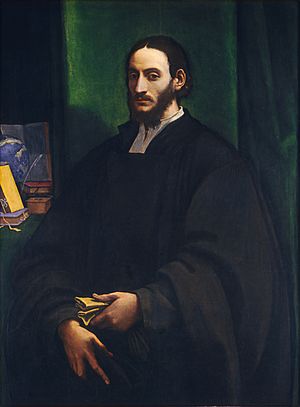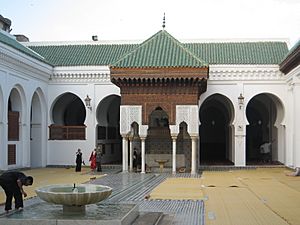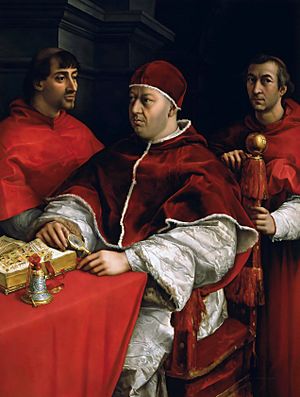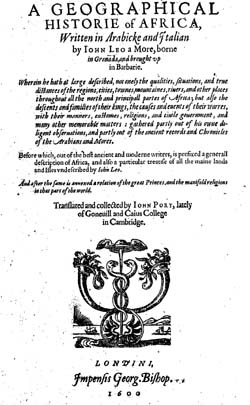Leo Africanus facts for kids
Quick facts for kids
Leo Africanus/al-Hasan Muhammad al-Wazzan al-Fasi
|
|
|---|---|

Portrait of a Humanist, c. 1520. The identity of the sitter is unknown but suggested possibly to be Leo Africanus
|
|
| Born |
al-Hasan Muhammad al-Wazzan
c. 1494 |
| Died | c. 1554 (aged c. 60) |
| Occupation | Diplomat, geographer, traveler and scientist |
|
Notable work
|
Description of Africa |
Leo Africanus (born al-Hasan Muhammad al-Wazzan al-Fasi, around 1494 – about 1554) was a famous traveler, diplomat, and writer. He was from a group of people called the Berbers in Al-Andalus (which is now Spain). He is most famous for his book Description of Africa, published in 1550. This book described the geography of North Africa, especially the Maghreb region and the Nile Valley.
For a long time, his book was considered the best source of information about Africa in Europe. Because of this important work, Leo Africanus became very well-known among geographers. He was originally Muslim but later became Christian, changing his name to Johannes Leo de Medicis.
Contents
The Life of Leo Africanus
Most of what we know about Leo Africanus comes from notes he wrote in his own books. He was born as al-Hasan, son of Muhammad, in Granada around 1494. We can guess his birth year from how old he said he was during different historical events.
His family moved to Fez in Morocco soon after he was born. In Fez, he studied at the University of al-Qarawiyyin, a very old and famous university.
Early Travels and Capture
As a young man, Leo went with his uncle on a diplomatic mission, which is like a special trip for government business. This journey took him all the way to the city of Timbuktu around 1510. At that time, Timbuktu was part of the Songhai Empire.
In 1517, while returning from another diplomatic trip to Constantinople, he was in the port of Rosetta during the Ottoman conquest of Egypt. He continued his travels through Cairo and Aswan, then crossed the Red Sea to Arabia. There, he likely went on a pilgrimage to Mecca, a holy city for Muslims.

On his way back to Tunis in 1518, Spanish pirates captured him near the island of Djerba or Crete. He was taken to the island of Rhodes, where the Knights Hospitaller (a Christian military group) had their base. Usually, Muslim captives who couldn't pay a ransom became slaves on Christian ships. However, his captors realized he was very smart and important. So, they sent him to the Castel Sant’Angelo in Rome and presented him to Pope Leo X.
Life in Rome
Pope Leo X soon set him free and gave him money to encourage him to stay. Leo Africanus was baptized (became Christian) in the Basilica of Saint Peter's in 1520. He took the Latin name Johannes Leo de Medicis, which means Giovanni Leone in Italian. In Arabic, he called himself Yuhanna al-Asad al-Gharnati, meaning "John the Lion of Granada."
The Pope likely welcomed Leo Africanus because he was worried that Turkish forces might invade Italy. Leo could provide useful information about North Africa.
After Pope Leo X died in 1521, Leo Africanus left Rome. The new Pope, Adrian VI, was suspicious of a Muslim in the court. Leo spent the next few years traveling in Italy. While in Bologna, he started writing a medical vocabulary in Arabic, Hebrew, and Latin. He also worked on an Arabic grammar book.
He returned to Rome in 1526 under the protection of the new Pope, Pope Clement VII, who was a cousin of Pope Leo X. In the same year, Leo Africanus finished his important book about African geography.

Publishing His Famous Book
His book was published in Italian in 1550 by Giovanni Battista Ramusio in Venice. Its full title was Della descrittione dell’Africa et delle cose notabili che ivi sono, per Giovan Lioni Africano. The book became very popular and was printed five more times. It was also translated into other languages, like French and Latin in 1556, and English in 1600. The English version was called A Geographical Historie of Africa.
Where Did He Go Next?
No one is completely sure what happened to Leo Africanus later in his life.
- One idea is that he stayed in Rome until he died around 1550, the year his book was published.
- Another idea is that he left Rome before it was attacked in 1527. He might have returned to North Africa and lived in Tunis until after 1550. This idea comes from records by a German scholar who wanted to meet Leo in Tunis, believing he had become Muslim again.
- A third idea suggests he left Tunis after it was captured in 1535 and went to Morocco. This is because he had family there and might not have wanted to live under Christian Spanish rule again. He also wrote in his book that he hoped to return to his home country.
How Accurate Were His Travels?
It's unlikely that Leo Africanus visited every single place he described in his book. He probably got a lot of information from other travelers he met. For example, it's not certain if he ever crossed the Sahara desert or visited places like Hausaland and Bornu. He might have gathered information from other travelers he met in Morocco.
When Leo visited Timbuktu, it was a busy Islamic city known for its learning. It had many scholars and a large library at its Great Mosque. Timbuktu was also a center for trade, dealing in gold, cotton, and Islamic books.
What's in a Name?
In one of his old handwritten notes, Leo Africanus signed his name in Arabic as Yuhanna al-Asad al-Gharnati. This means "John the Lion of Granada," which is a translation of his Christian name, John-Leo. He was also given the family name Medici because of his supporter, Pope Leo X. The same note also showed his original name: al-Hasan ibn Muhammad al-Wazzan al-Fasi. "al-Hasan ibn Muhammad" means "al-Hasan, son of Muhammad," and al-Fasi means he was from Fez, Morocco.
His Writings
Cosmographia et geographia de Affrica, later published as Description of Africa in 1550, is Leo's most famous work. This book gave Europeans a detailed look at the geography, customs, and cultures of North Africa.
He also wrote an Arabic-Hebrew-Latin medical vocabulary for a Jewish doctor named Jacob Mantino. Another work was an Arabic translation of the Epistles of St. Paul, finished in 1521. This manuscript is kept in the Biblioteca Estense in Modena, Italy.
Leo Africanus also wrote a biographical encyclopedia about 25 important Islamic scholars and 5 important Jewish scholars. This book was finished in Rome before he left in 1527. It wasn't as well-known as his Africa book and contained some mistakes, probably because he had to rely on his memory for information while in Italy.
In Description of Africa, he mentioned plans to write other books, including descriptions of the Middle East and Europe, a book about the Islamic faith, and a history of North Africa. However, none of these books have survived, and we don't know if he ever finished them. This might be because he possibly returned to North Africa.
See also
 In Spanish: León el Africano para niños
In Spanish: León el Africano para niños


